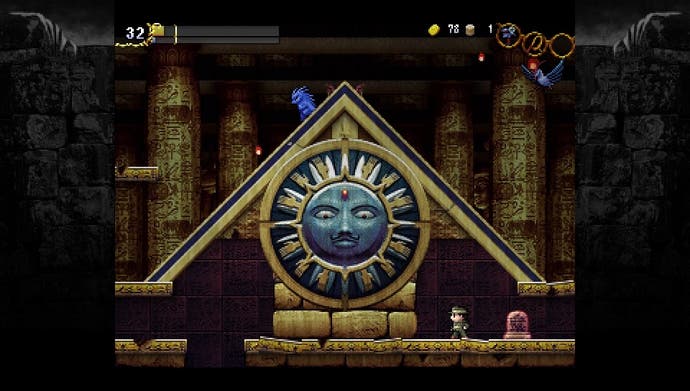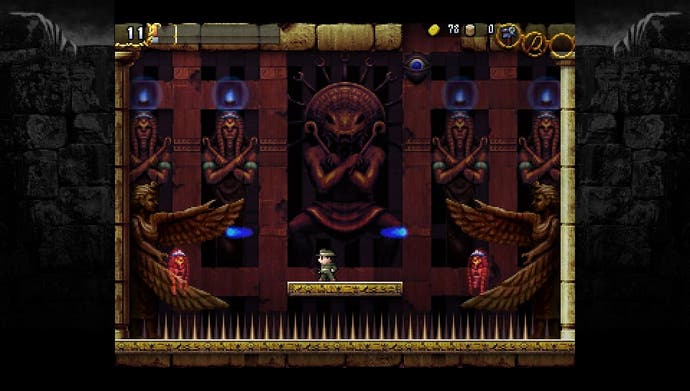La-Mulana EX review
Indy games.
Indiana Jones must spend long hours off-camera trying half-baked solutions to insurmountable ancient riddles - but his death-defying successes make for more thrilling fiction. The whip-wielding protagonist of La-Mulana, Lemeza Kosugi, has a lot in common with Indiana, except his own story is told via a series of gruelling failures.
The original 2005 La-Mulana was Nigoro's 16-colour tribute to the unforgiving difficulty of 1980s-era MSX games, as well as the exploration-based environmental storytelling of 90s games like Super Metroid. The recent remake for the PlayStation Vita offers some additional content - hence the "EX" in the title - such as a Monster Bestiary, which catalogues the various manticores and serpents that Lemeza encounters in the course of his scavenging and tablet-scouring. The remake does not alter the original resolution or implement any touch-screen functionality on the Vita; the game appears in a letter-boxed square at the centre of the screen.
The unapologetic difficulty and repetitious die-try-die-again nature of La-Mulana lends itself well to a handheld device. Playing in short bursts on the go helps make the game feel more rewarding, even though progress is slow and the puzzles are punishing. The PS Vita version, designed by Pygmy Studio, also claims to include more sign-posting and player direction than the original game did, but La-Mulana still has many mysteries that can only be understood by players willing to search online for a digital copy of the manual.

For example, stone tablets of a certain shape double both as locations for important in-game messages but also as save points, depending on which button you press - and you should press both in turn, because in addition to saving when you can, you must also read every tablet you come across for riddle-solving purposes. Chests aren't intuitive either; each one involves performing a different action or solving a different type of puzzle in order to open it halfway, at which point Lemeza must hit the chest with his whip in order to open it the rest of the way. Why would this be, given that chests in every other game can be opened by standing directly in front of them and pressing either an action button or an "Up" arrow? Why would standing back a half-open chest and hitting it with a whip be the key to opening it? Goodness knows - and that's only the tip of the iceberg when it comes to La-Mulana's highly unusual solutions to simple in-game problems.
The game simply does not include enough information internally to help anyone beat it on their own; brute-forcing puzzles without the help of a walk-through would have taken me weeks. Much of the game's puzzles involve events transpiring in a non-intuitive order; killing a monster in one area may cause an event to trigger in a completely separate area, such as a falling box or a flipped switch - but there's rarely much indication as to why or how certain actions will trigger others. The game's stone tablets offer beautifully worded riddles aimed at helping the player to solve each level's more complicated puzzles, but smaller stuff like invisible bridges, false walls, and stubborn chests require a lot of trial and error - or a quick Google search or two.
The game is difficult, as promised; many monsters require super-fast reflexes and multiple whip-slashes to defeat, and my memory got a work-out as well when it came to keeping track of false floors and invisible spikes. However, I didn't consider the game's puzzles to be difficult so much as frustratingly random. Since the bulk of game lends itself so well to an on-the-go format of play, I felt disappointed when I had to dig my phone out of my pocket to figure out how to progress. I preferred to plough through tombs in short bursts while waiting at bus stops, appointments, and lunch dates - but many portions of the game are too inaccessible and opaque to solve without additional help from a walk-through or a forum thread. I don't mind fighting a tricky monster over and over again, but having to reach for my phone just to look up how to turn off a power switch felt far more frustrating - especially if I'd already wasted an hour trying intuitive solutions that had no effect. Often the "real" solution would turn out to be something far more bizarre, like defeating a monster in a completely different area.

Comparisons abound between this game and Super Metroid, but those comparisons only further impacted my disappointment, given Super Metroid's gift at gently guiding the player in the right direction while telegraphing new power-ups and unexplored areas, each map and save point placed in a logical spot along the way. Sometimes, I felt a taste of that exploratory zeal in La-Mulana when I happened to unlock everything in the right order, but most of the time, the game's puzzles felt like misguided guesswork. I can only imagine how much more opaque the original game must be, given that "EX" promises more sign-posting and a more accessible experience for a new player.
In spite of the overall difficulty - and the frankly hackneyed protagonist and setting - La-Mulana EX has an underlying charm and a rhythm that made even my constant failures feel like a relaxing meditation. The Vita build moves smoothly; re-loading prior saves was thankfully simple and quick each time. As with all exploration games, La-Mulana requires re-visiting the same areas over and over until you've unlocked every last secret on offer.
I wouldn't go so far as to call the game addictive, but I did fall into a state of relaxing flow as I played, aided by the sprightly soundtrack and the predictable patterns of endlessly re-spawning enemies, each of whom became as familiar to me as old friends. Unfortunately, all of these charms only made La-Mulana's moments of confusion and frustration all the more disappointing, given the pleasure I had felt towards the game in its stronger levels. La-Mulana wants to be a difficult game, but it doesn't seem to understand what makes old games like Super Metroid work so well: a fundamental respect for the player's intelligence and patience.
If a game telegraphs for me where I should go and what I should do - however subtly - I will figure it out, eventually. I don't want to have to guess every time. If I wanted random encounters with no respect for my time, I could put down my Vita and engage with the real world for once. And why would I want that?








